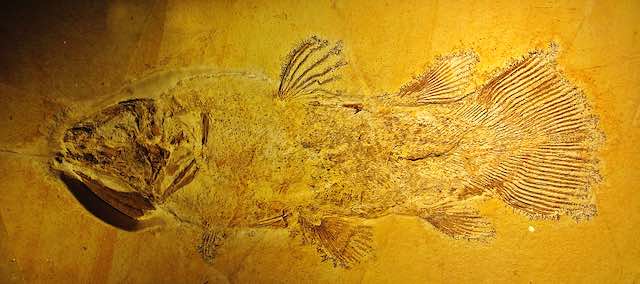While I attended geology classes at the University of Texas (UT), we were taught how to identify the age of certain rock layers. One of them, called the Devonian layer, was “known” to be 400 MY (million years) old, because of the presence of an index fossil: the coelacanth [SEE-la-kanth]. Looking like a carp the length of a king mattress, this extinct creature was also held up as the premier specimen of fish who left the ocean to walk on leg-fins, because the fossils showed lungs, a large brain, and four appendages that “look similar” to tetrapods (four-legged land walkers). It disappeared from our alleged evolutionary lineage 65 MY ago, blazing a path for amphibians, birds and mammals (see photo, below).

Coelacanth Fossil. Evolutionists used this as an index fossil, meaning all rocks containing this fossil were 70- to 400-million years old. Source: Wikipedia commons.
It seemed reasonable to rest on this rock until I read about a boy fishing off the coast of Madagascar in 1938 who hauled one up in his net. Wondering what it was, he turned to Marjorie Courtenay-Latimer, a South African museum curator and frequent visitor to the pier. She took his 127-lb catch to a taxidermist, then studied and documented it. A fellow curator who specialized in fish realized it was a coelacanth, and thus “a living fossil” (see photo, below).[1] Named in her honor, over 300 of genus Latimeria have been found off the South African coast living in caves 500-2,300 feet below surface. Studies have shown its eyes are perfectly suited for vision in dark depths; if it ventured into a shallow estuary, it would be functionally blind. Its brain is super-tiny. Instead of a lung, it has an oil-filled swim bladder which makes it neutral buoyant around 600-900 feet. DNA sequencing of Latimeria since then showed it’s like other fish, not land animals, and slowly changing.[2] And just how does it use those leg-like fins? In 1987, a German team led by Hans Fricke filmed six coelacanths in their natural habitat. Were they crawling? Hardly! They spend their time bottom feeding, using those fins to support a head-down position — far from practicing a walk on land! Coelacanth is perfectly suited for life in the deep, not on land. [3]

70-million-year-old fish? The coelacanth was thought to be extinct until 1938 when fisherman off the island of Madagascar hauled one up. Behind the fish is the South African museum official Marjorie Courtenay-Latimer who identified the living specimen as coelacanth.
These findings delivered ugly impacts to evolutionists’ bold assertions. A living coelacanth identified as an index fossil means neither are old nor undergoing evolutionary change. Scientists’ initial claims of a large brain, primal lungs and weight-bearing fins now stink after a living fish came up from the depths and was sliced open. Those deep Devonian rock layers aren’t millions of years old either, and thus neither are the many layers on top. All the observable and measurable data supports an intelligent Creator and a recent global flood. He that is first in his own cause seemeth just; but his neighbour cometh and searcheth him. What a reversal – scientists deep fried by a fish!
[1] Latimer’s story and photo with her fish from Smithsonian Magazine.
[2] Coelacanth facts from Institute for Creation Research.
[3] Coelacanth headstands, Dr. Walt Brown, In The Beginning, 7th ed., pg. 29.
Like this? Consider sharing it to Facebook by clicking the linked icon below.
